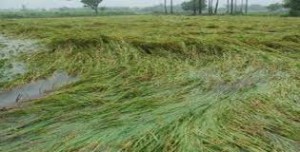 Large scale damage occured to crops due to unseasonal rain over the past few days. The rain affected the crops in Telangana and Andhra Pradesh, UP and MP.
Large scale damage occured to crops due to unseasonal rain over the past few days. The rain affected the crops in Telangana and Andhra Pradesh, UP and MP.
With referece to reports, one lakh hectares were damaged in Andhra Pradesh and 11,628 hectares were destroyed in Telangana due to strong thunderstorms and incessant rain.
In many places in both the states, farmers who transported their early harvest to market yards also suffered in the absence of any protection from the rain. Left with soaked produce, farmers protested at various market yards.
According to initial estimates, the mango crop in Andhra Pradesh was badly hit with strong gales causing severe fruit dropping.
In Telangana, paddy was the worst-hit crop. Other crops to suffer significant damage were bajra, jowar and green gram. Mango orchards also suffered damages. Poultry farmers, too, were also affected. In Jagityal area of Karimnagar, 50,000 chickens were reported dead following heavy rain.
The AP government announced an ex-gratia of Rs 4 lakh to the next of kin of those killed on account of rain-related episodes, while the Telangana government announced a compensation of Rs 5 lakh for such families.
In UP, rain and thundershowers lashed various districts for the second consecutive day on Monday, pushing many farmers to the brink of penury. While the rain in March had already damaged about 50% of pulses and wheat, the return of wet weather has exposed farmers to a food crisis. They are now losing whatever standing crops were left in the fields.
“We’ve already lost what we had earmarked for sale,” said Ram Sanjivan, a farmer from Mirzapur. “Now, we’re losing the crop we had saved for our consumption.”
Bundelkhand, central and eastern parts of UP recorded more rain than the western part on Monday. Rae Bareli was the wettest district (21.8 mm rain), followed by Lucknow (18.6 mm), Varanasi (17 mm) and Sultanpur (12.7 mm).
In Madhya Pradesh, unseasonal rain on Sunday damaged thousands of quintals of wheat kept in open for government purchase across the state. The administration stopped purchase till April 15 in the wheat-producing Hoshnagabad and Harda districts.
In Narsinghpur, officials said 9,000 quintals of wheat was damaged. “Actual loss will be less since wheat is being dried,” district collector Narsingpur Naresh Pal told TOI. “We’ve started a probe and action would be taken against those who haven’t acted in responsible manner.”
In Harda, around 2.5 metric tonne of wheat got damaged because of rain. In Hoshangabad, officials were busy assessing the damage. “Here, wheat was kept in covers, but the water exit was blocked,” said Jagdish Kumar Sarsar, general manager of Civil Supplies Corporation at Hoshangabad. “So, when it rained, the water seeped in. Wheat sacks kept on the lower rakes became wet.”



